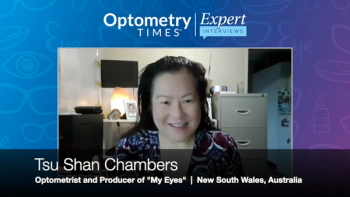
- November digital edition 2022
- Volume 14
- Issue 11
DED: Developing a 360° diagnosis and treatment plan
Modern technology enables early detection, individualized solutions.
I’ve embraced dry eye disease (DED) from the day I bought my practice. After a few years, I opened a second location, a medspa dedicated to dry eye and aesthetic conditions that affect the eyes. There is always something new to learn and offer patients with DED.
However, every treatment plan I make is shaped by 2 essential lessons: diagnose early so patients can get treatment before they progress and treat aggressively from multiple angles to bring this multifactorial, progressive condition under control.
Today’s dry eye technologies make it possible to deliver a complete 360° diagnosis and treatment plan for every patient.
Talk, test, and retest
In my regular practice, I screen for DED with a goal of efficient diagnosis so we can initiate treatment early. While in the dry eye medspa, where I see medical cases after diagnosis, I delve deeper into all factors involved and perform ongoing treatment. The key tools are a detailed history, conversation, and objective testing.
Patient forms
To understand a patient’s dry eye, we need to collect in-depth information about their overall health, known medical conditions, current medications, habits, lifestyles, screen use, and home and work environments. When patients make an appointment, we send them detailed history forms to complete in advance. The form asks not only about health conditions, medications, and supplements, but also about discomfort and dryness, fluctuating vision, eye fatigue, what time of day their eyes feel worst, and what treatments they’re using.
In-person discussion
The form prompts an in-person dialogue, during which I ask for more depth and details. This requires some knowledge from the practitioner, such as knowing that blood pressure medications cause dry eye and whether the patient’s signs and symptoms indicate that a thyroid or autoimmune disease work-up from the patient’s primary care doctor might be in order.
Objective tests for everyone
In addition to the history and exam, we perform a few objective screening tests for DED, including meibography (LipiScan; Johnson & Johnson Vision) and vital dye staining. Osmolarity testing (such as the TearLab Osmolarity System) tells me if the tears are unstable or in healthy homeostasis.
Objective tests for complete dry eye exams
In addition to screening tests, patients who are referred for dry eye exams have more extensive testing. My slit-lamp system of Mediworks’ S390L (Firefly WDR) Slit Lamp Microscope and Oculus' Keratograph 5M do a host of objective tests, including meibography, anterior segment photos and videos, vital dye staining, noninvasive tear breakup time (NITBUT), objective redness scores, and imaging of the tear film’s oil layer.
When I express the glands, I take video so I can show patients what their oil looks like. I check and count functioning meibomian glands (Meibomian Gland Evaluator; Johnson & Johnson Vision) and test for the matrix metalloproteinase 9 inflammatory mediator (InflammaDry; Quidel Corporation). I’m also starting to test corneal nerve sensitivity on every patient and ordering bloodwork in some cases to learn more about hormones, potential vitamin deficiencies, and omega-3 levels.
Tracking progress
Once I initiate treatment, I continue to see the patient about once a month. Objective tests allow the patient and I to track their progress, and if patients can’t immediately see or feel the results, the proof they see in objective tests often encourages them to keep going. My patients are especially interested in their osmolarity score, NITBUT, and meibography.
When we collect all this data, it’s easy to flip the screen and show patients their numbers and videos. They see all the puzzle pieces come together and get a big picture of what’s going on with their body, paving the way to discuss a treatment plan.
360° treatment approach
Many of my first-line therapies are those that doctors generally consider second-line therapies. However, I’ve found that being aggressive lets us get results in months, rather than allowing the disease to progress while we take a stepwise approach. I explain to patients that dry eye is chronic and progressive and that to establish a management protocol, I’ll need to see them every 2 to 4 weeks for 6 to 12 months, followed by annual visits. Patients feel confident that we’ll utilize all the options at our disposal to manage dry eye effectively.
Traditional therapies and lifestyle changes
Educating patients about lifestyle and environmental changes is the first step in treatment. Patients also start traditional at-home therapies, which can help in addition to in-office procedures and medications. My patients use hot compresses, take good omega-3 supplements, do blink exercises, and use a lid wash.
Intense pulsed light therapy
Almost all my dry eye patients have intense pulsed light (IPL) therapy (Optima IPL; Lumenis), either alone or in addition to thermal evacuation, because IPL tackles the condition from many different angles, including addressing bacterial overload and inflammation, and improving meibomian gland functionality through photobiomodulation. Patients have 4 sessions scheduled 2 to 4 weeks apart, followed by maintenance every 6 to 12 months.
Thermal evacuation
The Meibomian Gland Evaluator (Johnson & Johnson Vision) tells me how clogged a patient’s oil glands are; in most cases, the clogged glands would benefit from thermal evacuation. I use several different devices, including LipiFlow (Johnson & Johnson Vision), Systane iLux (Alcon), NuEra (Lumenis) radiofrequency, and TempSure Envi (Cynosure) radiofrequency platform. I explain the options and recommend a choice based on the patient’s individual needs. (For example, I’d recommend radiofrequency for eyes with poor lid apposition.)
Eyelid cleaning
Mechanical cleaning of the eyelids (NuLids, NuSight Medical; Zocular Eyelid System Treatment [ZEST], Zocular) provides a cleaner lid margin. It can also be helpful to clear the meibomian glands of lid debris before thermal evacuation.
Medications
Dry eye medications such as cyclosporine ophthalmic solution 0.09% (Cequa, Sun Pharma; Restasis, Allergan), lifitegrast ophthalmic solution 5% (Xiidra; Novartis), and varenicline solution (Tyrvaya; Oyster Point Pharma, Inc) help with long-term control of DED. For patients with corneal neuralgia, I prescribe cenegermin-bkbj ophthalmic solution 0.002% (Oxervate; Dompé US Inc) human nerve growth factor. Patients who experience flares benefit from a short 2-week course of steroids such as loteprednol etabonate suspension 0.25% (Eysuvis; Alcon).
Biologics
In some cases, biologics such as amniotic membranes (Prokera; BioTissue, Inc) or analogous platelet-rich plasma eye drops can be beneficial.
After we initiate treatment, I tell patients to expect to feel improvement after 6 to 8 weeks. They often feel better sooner, but I would rather give them a pleasant surprise than a disappointment. At each visit, my patients and I continue to track their progress with osmolarity scores, NITBUTs, meibography, and other tests.
360° cases
To give you a picture of the 360° approach to dry eye care, let’s look at a few cases. One patient was finally able to get free from debilitating photophobia.
Patient
A 64-year-old woman had a large visual complaint, extreme light sensitivity, and blur. The problem was affecting her computer-intensive work. She had failed on lifitegrast ophthalmic solution 5% and cyclosporine ophthalmic solution 0.09% and was currently taking varenicline solution and cyclosporine ophthalmic solution 0.09%. Previously, she had 3 LipiFlow treatments, multiple amniotic membranes, and low-level light treatment and used Regener-Eyes Ophthalmic Solution, Professional Strength (Regener-Eyes).
Testing
The patient had significant corneal staining (Figure 1). Her TearLab scores were 328 OD and 340 OS.
Treatments
The patient underwent low-level light treatment and thermal evacuation. I continued her with Regener-Eyes, put her on cenegermin-bkbj ophthalmic solution 0.002% for neurotrophic keratitis, and initiated lid hygiene, nutraceuticals, and blink exercises.
Results
Corneal staining was resolved, and TearLab scores dropped to 302 OD and 312 OS. The patient reports that her vision is much clearer and that her light sensitivity is gone. We scheduled maintenance procedures to continue her success.
In another case, a very intensive computer user actually increased screen time after therapy.
Patient
A 56-year-old woman had experienced mild dry eye for about 30 years, ever since she underwent photorefractive keratectomy. She was working on a computer screen all day. Lifitegrast ophthalmic solution 5% alone had failed to help.
Testing
The patient had a standard patient evaluation of eye dryness (SPEED) score of 17. Her TearLab scores were 322 OD and 317 OS. Meibography showed glands blocked with inspissated meibum (Figure 2).
Treatments
We initiated IPL, iLux, radiofrequency, lid hygiene, nutraceuticals, blink exercises, and Regener-Eyes.
Results
The patient’s TearLab scores declined to 297 OD and 295 OS, and her SPEED score dropped to 3. She is now able to wear contact lenses (one of her major goals), and the significant improvement in symptoms has even allowed her to increase her workload.
Conclusion
Not all cases are this difficult. Certainly, treatment is easier in dry eye’s early stages, which makes screening so important. But a 360° approach is very well suited in either case, making dry eye management more comprehensive and reliably effective.
Articles in this issue
almost 3 years ago
Words matter: Update how you talk to your patientsalmost 3 years ago
Monitor keratoconus progression after cross-linking treatmentalmost 3 years ago
Have a patient with diabetes? Get the whole storyabout 3 years ago
Electroretinography is not what it used to beabout 3 years ago
Reuse corneal tissue to manage multiple conditionsabout 3 years ago
Fitting and troubleshooting tips for scleral lens successabout 3 years ago
Offer advanced patient care by bundling servicesabout 3 years ago
The riddle of managing glaucoma: accounting for lurking variablesabout 3 years ago
Pediatric vision and digital media: A bad combinationNewsletter
Want more insights like this? Subscribe to Optometry Times and get clinical pearls and practice tips delivered straight to your inbox.



















































.png)


